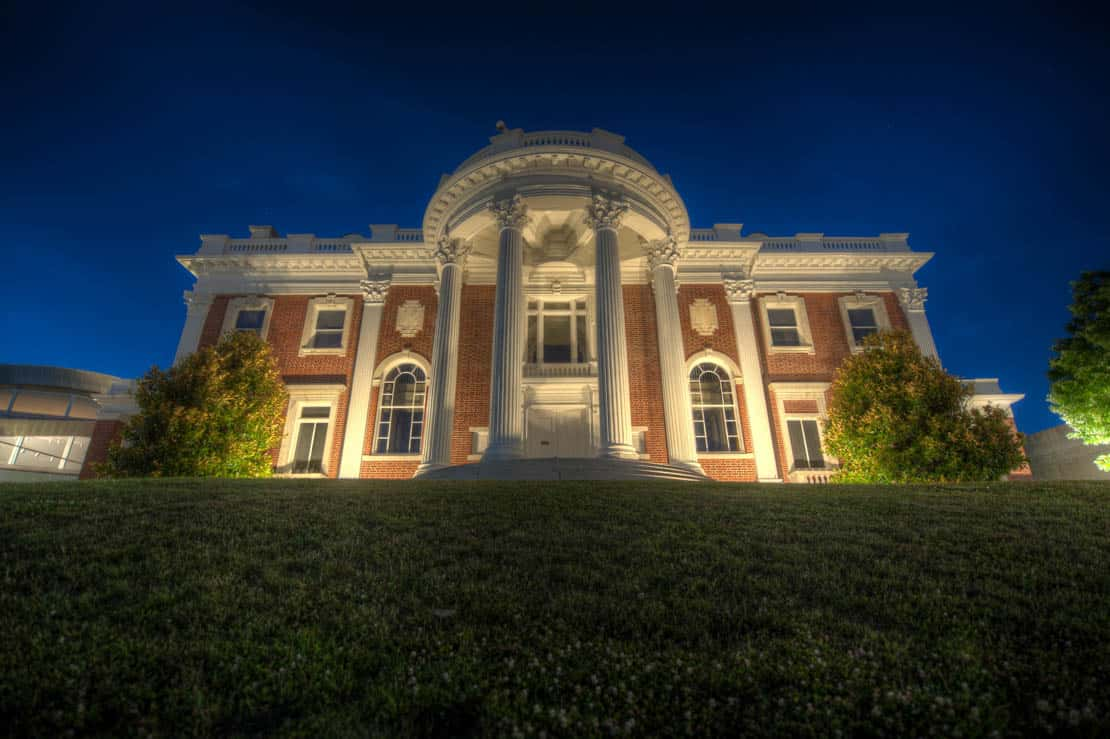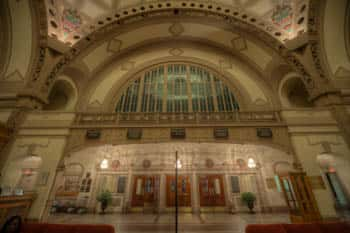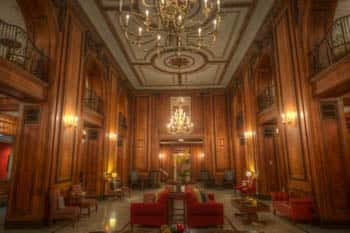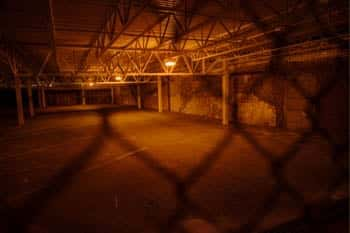Glancing up at the Chattanooga skyline, there’s one building that never fails to capture the eye: the Hunter Museum of American Art.
For nearly a hundred years, this museum has been home to priceless artwork and antiquities, and it remains today one of the most influential properties in Chattanooga, Tennessee. A visit to the city just simply isn’t “complete” until you’ve made a stop at the Hunter Museum.
Seated up on the bluff, this converted mansion is a testimony to the determination and philanthropy that Chattanooga locals naturally exhibit. But for all of its famed art and historical prevalence within the City, the Hunter Museum once played a key role in one of the most notable mysteries that Tennessee has ever seen.

And if you believe the rumors, the poor victim of this crime is said to still haunt the Hunter Museum of American Art today.
In the earliest days of Chattanooga’s history, the bluff that the Hunter Museum sits on currently was of prime importance to the Cherokee tribe. It was the highest point along the Tennessee River, and the Cherokee adamantly believed that it was also the home to their sacred (and giant) mythical hawk, Tia-Numa.
By the 1800s, however, the Cherokees had all but been removed from the area and in 1854, an iron smelting plan was constructed on the land, where the northwestern corner of the Hunter Museum stands today.
This plant was known as “Bluff Furnace,” and remained one of the earliest Southern industrial enterprises. With the onslaught of the Civil War, the iron smelting rolled to a temporary stop before being destroyed during the War itself. Union and Confederate forces used the bluff as a lookout--Chattanooga in the 1860s was a battlefield that drew lines of blood.
This bluff would sit unused until the late nineteenth century, when one of the richest families in Chattanooga built what would be the mansion that is still used for the Hunter Museum.
In 1904, Ross Faxon hired a Cincinnati architectural firm called Mead and Garfield to design a home for his family. Faxon himself was rich as croesus--naturally, he was an insurance broker--and within a few short months he and his family had moved into the Edwardian-style mansion on the bluff. It was built with hand-carved woodwork, and even today, the sconces, fixtures, and even the acanthus leaf and fruit-and-flower ornamental motifs are original.
For almost a decade, the Faxon family called the Bluff home before selling it off. It was not until 1920 that the property landed in the hands of one of Chattanooga’s most prominent families: the Thomas’.
Anne Taylor Thomas, the widow of Benjamin F. Thomas, was the property’s buyer. Before his death, her husband Benjamin had been one of the founders of Coca-Cola--yes, that Coca-Cola bottling company.
Interestingly enough, Benjamin Thomas’ nephew had moved to Chattanooga the same year that the mansion had been built--1904. George Thomas Hunter would later own the property itself, but at the young age of 17, he had a ways to go. He sent years working as a clerk at his uncle’s Coca-Cola company. He then climbed the ranks to a secretarial position, then later he was given the role of president. By the time he became a chairman of the board and had inherited the company from his uncle, the Coca-Cola business had taken over the country.
Aside from being incredibly wealthy, Hunter accrued a reputation as a philanthropist in Chattanooga. He gave readily to the poor and created the Benwood Foundation, which was a private charitable trust.
In 1951, George Thomas Hunter passed away. And, as almost all historians and scholars point out, Hunter died unmarried and childless.
Although George Thomas Hunter passed on, his love of artwork and antiquities lived on when the Chattanooga Art Association requested a meeting with Hunter’s charity, Benwood Foundation. They hoped that the Faxon-Hunter mansion might be donated to the Art Association, so that the organization could build an art museum.
The Benwood Foundation agreed, and less than a year later on July 12, 1952, the George Thomas Hunter Gallery of Art was opened.
Over the years, the Hunter Museum has seen restorations and renovations. In 1975, a new building was added to the complex. Unlike the Edwardian-style mansion that had once belonged to the Faxon and Hunter families, this new building had a completely different aesthetic. Comprised of concrete with a beautiful central atrium, not only did the Hunter Museum go on to win major architectural awards, but Chattanooga’s skyline was forever changed.
With the construction of the new building, the George Thomas Hunter Gallery of Art earned a new name as well: the Hunter Museum of Art. The Benwood Foundation also bequeathed the museum with 40 American paintings that were valued at roughly one million dollars.
The Hunter Museum of Art was truly ready to take on the art world--and it did so brilliantly, accumulating so many donors, visitors and artwork that the museum grew exponentially.
After sixty years seated up on the highest bluff in Chattanooga, the Hunter Museum of Art shows no signs of slowing down. They recently partnered with the Tennessee Aquarium as well as the Creative Discovery Museum in order to lay the foundation for new exhibits. And, with an eye always on the future, the Hunter Museum of Art will no doubt stand up on the bluff for at least another sixty years.
And with it, its ghosts too.
For those who work at the Hunter Museum of Art, talk of ghosts and hauntings is the norm.
According to Katrina Craven, the spokeswoman for the Hunter Museum of American Art, the mansion part of the museum is reportedly haunted by five ghosts. Employees often claim to feel as though they are being watched, and it’s not uncommon for security who stay late at night to be spooked by shadows moving within the cover of darkness.
As for these five spirits, only one has been personally identified--poor Miss Augusta Hoffman.
“They say it is Aunt Gussie’s skeleton and that we murdered her” -- Mrs. Bennett, St. Louis Post-Dispatch, 1924
It was 1915 in Chattanooga, Tennessee, and sixty-year-old Augusta Hoffman was living with her sister and her sister’s family at No. 15 Bluff View, just next door to the Hunter’s grand estate. In fact, the Hoffman and Bennett family actually were the family’s tenants. While they may not have mingled on a daily basis, they were familiar with each other in a way that only neighbors can be.
According to the St. Louis Post-Dispatch, Augusta Hoffman was a “pathetic old woman, living as a boarder with her sister, Nancy Bennett, and her nephew, William.” Despite owning a small bit of property in Knoxville, Hoffman did not make enough money to be self-sufficient and so she took up needlepoint for Mrs. Mollie McGraw, a local dressmaker. Sometimes she made dresses for Mrs. J. S. Hunt next door at No. 13 Bluff View, but most of the time, Augusta remained in the house.
Then, one day in 1915, Augusta Hoffman disappeared.
No authorities were called. The Bennetts claimed that Augusta had up and married a man in Knoxville. Mrs. Bennett, William’s wife, later told police that Augusta “left our home, saying that she was going to Knoxville and marry a man there named Brown. She was always very secretive about her private affairs.”
Reportedly, the Bennetts received letters from Augusta for almost two years. They came from Washington and New York, Cleveland as well as Santa Cruz, California. Most were signed by Brown, Augusta’s husband, but he always mentioned Augusta’s welfare--or so the Bennetts claimed. When the elder Mrs. Bennett died in 1916, the letters stopped coming.
The Bennetts thought nothing of it. Augusta was a peculiar woman, they said, and she’d only been close to her sister. The following year, the Bennett family moved away from Chattanooga, first to Knoxville and then to Roma, Georgia.
In 1924, Mrs. Hunt decided to have the basement floor at No. 15 Bluff View redone. But the carpenters were not the most thorough, and upon seeing the rotten floorboards they ripped them all up.
One worker’s hammer came back up with a chunk of bone. Allegedly, he said, “That’s funny,” and proceeded to dig some more.
The end result was a shallow grave, and in that shallow grave was a skeleton. “Of its clothing only the shoes were left,” the St. Louis Post-Dispatch reported in 1924. “Shoes and a pair of spectacles and false teeth grinning eerily from the skull.”
Immediately, the police were called and homicide investigation launched. Witnesses came forward with reasons as to why the body was, in fact, Augusta Hoffman.
Even Mrs. Hunt reportedly told the police, “Now that you speak of it, there was an old lady here one time who disappeared suddenly. We were told she went way and got married.”
Mrs. McGraw, the dressmaker, told the police that Augusta had left without her final paycheck. And a dentist in Knoxville confirmed that the dentures in the skeleton’s mouth, were indeed the same pair he’d created for Augusta years earlier.
Police reports claimed that “the body to which the skeleton belonged appeared to have been burned with acid, for the hair was gone and the clothes destroyed, which, experts say, would not ordinarily decay completely in nine years.”
With the outcry of evidence from the citizens in Chattanooga, Mr. and Mrs. Bennett stood not a chance in avoiding persecution.
Still, the Bennetts maintained their innocence. When the initial accusations of homicide sprung up, Mr. Bennett was quick to point out that they had done everything in their power to reconnect with their elderly aunt.
He told the newspaper that after his mother had passed, they’d never heard from “Aunt Gussie again. We supposed she still felt piqued at us. Anyway, it was a lost trail. During the next years, we made efforts to locate her, but, supporting neither that she was in want nor had met with foul play, did not go to the police. That’s all we know. We didn’t hear any more about her until the discovery of this skeleton.”
A family who never bothered to alert the police that their aunt had married a man they’d never met--an aunt who was practically a recluse, at that--was not a sound enough argument for the Attorney-General in charge of the Hoffman case.
The police lured the Bennetts back up to Chattanooga under the premise of interviewing them. As soon as they crossed the city line, Mr. and Mrs. Bennett were arrested. The nail in the coffin was none other than the fact that detectives had scoured every wedding registry between Knoxville and Washington, D.C.
No marriage certificate had ever been issued to Augusta Hoffman.
As the Attorney-General said: “We’re going to point out that she disappeared and there was no hue and cry. We intend to show that she dropped out of sight and no one raised a finger to find her. We shall prove that while the Bennetts lived upstairs, the poor old lady was lying dead under the floor of their cellar.”
And prove this murder they did.
Although Augusta Hoffman was murdered and “buried” at No. 15 Bluff View, her spirit has been more frequently spotted next door at the Hunter Museum of American Art. The reason why eludes us to this day, but there are no shortage of ghost sightings at the museum.
Those embarking on ghost tours are often the ones who catch sight of her. In fact, one group claimed to see a feminine shadow peering out of the same window of the Hunter Museum, where Augusta’s spirit is known to hang out.
Her apparition has appeared in photos, and, despite the fact that once again she did not actually die at the museum, strange odors often catch on the breeze. Acidic, they say, sometimes rotten.
Is it possible that in death, Augusta Hoffman has sought the comfort of familiarity without wanting to remain in the space where she was brutally murdered? What other reasoning would this spirit have to haunt the next door Hunter Museum?
The whys are not known, and they may never be uncovered. But one thing is for certain: for those who work at the Hunter Museum of Art, they are all on a first name basis with the ghost of Miss Augusta Hoffman.
Are you looking to visit the Hunter Museum of American Art? We absolutely recommend doing so, as it is one of the key highlights of Chattanooga’s cultural history. Open Monday through Sunday, the Museum even offers “Throwback Thursdays,” which includes free admission on the first Thursday of every month from 4PM to 8PM.
With that said, if you’re hoping to hear about the dark side of the Hunter Museum’s history--including all of its ghostly lore--then there’s no better place for you to do so than on one of Ghost City’s ghost tours in Chattanooga.

Chattanooga's Famous Railroad

Chattanooga's most haunted Hotel

The Ghosts below your feet in Chattanooga